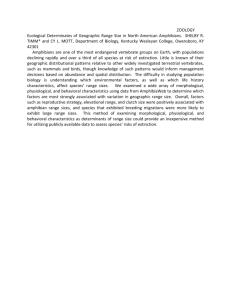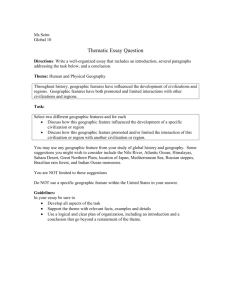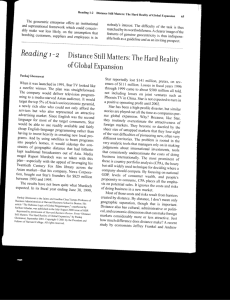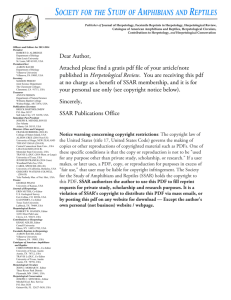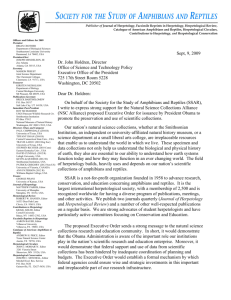Herpetological Review publishes brief notices of new geographic
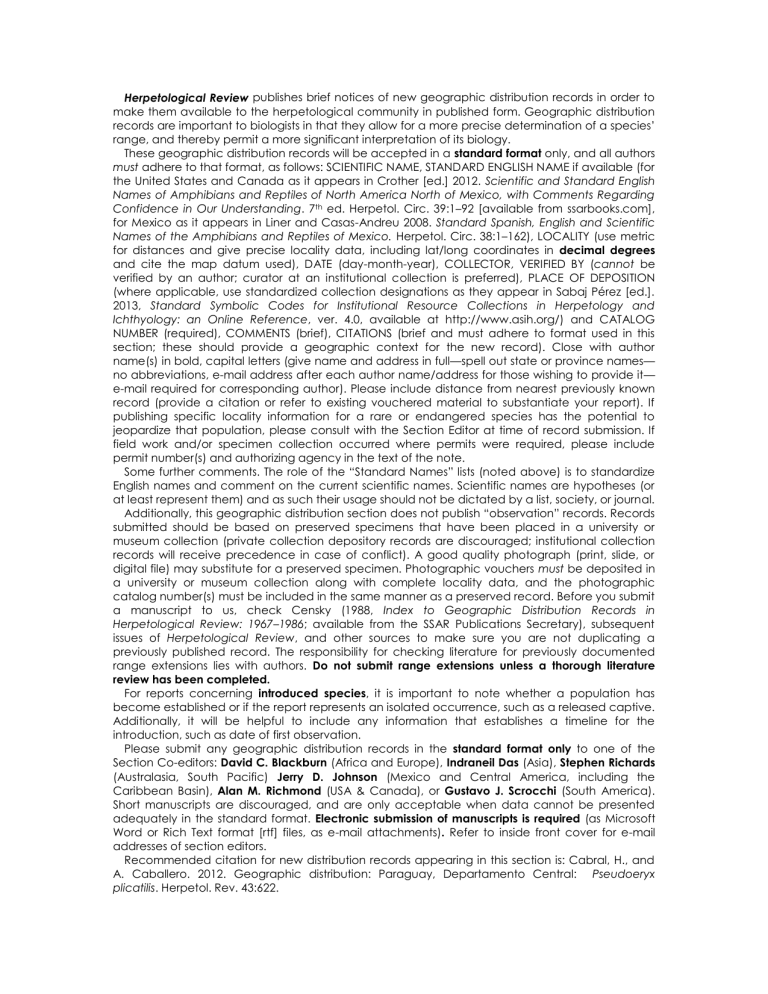
Herpetological Review publishes brief notices of new geographic distribution records in order to make them available to the herpetological community in published form. Geographic distribution records are important to biologists in that they allow for a more precise determination of a species’ range, and thereby permit a more significant interpretation of its biology.
These geographic distribution records will be accepted in a standard format only, and all authors
must adhere to that format, as follows: SCIENTIFIC NAME, STANDARD ENGLISH NAME if available (for the United States and Canada as it appears in Crother [ed.] 2012. Scientific and Standard English
Names of Amphibians and Reptiles of North America North of Mexico, with Comments Regarding
Confidence in Our Understanding. 7 th ed. Herpetol. Circ. 39:1–92 [available from ssarbooks.com], for Mexico as it appears in Liner and Casas-Andreu 2008. Standard Spanish, English and Scientific
Names of the Amphibians and Reptiles of Mexico. Herpetol. Circ. 38:1–162), LOCALITY (use metric for distances and give precise locality data, including lat/long coordinates in decimal degrees and cite the map datum used), DATE (day-month-year), COLLECTOR, VERIFIED BY (cannot be verified by an author; curator at an institutional collection is preferred), PLACE OF DEPOSITION
(where applicable, use standardized collection designations as they appear in Sabaj Pérez [ed.].
2013, Standard Symbolic Codes for Institutional Resource Collections in Herpetology and
Ichthyology: an Online Reference, ver. 4.0, available at http://www.asih.org/) and CATALOG
NUMBER (required), COMMENTS (brief), CITATIONS (brief and must adhere to format used in this section; these should provide a geographic context for the new record). Close with author name(s) in bold, capital letters (give name and address in full—spell out state or province names— no abbreviations, e-mail address after each author name/address for those wishing to provide it— e-mail required for corresponding author). Please include distance from nearest previously known record (provide a citation or refer to existing vouchered material to substantiate your report). If publishing specific locality information for a rare or endangered species has the potential to jeopardize that population, please consult with the Section Editor at time of record submission. If field work and/or specimen collection occurred where permits were required, please include permit number(s) and authorizing agency in the text of the note.
Some further comments. The role of the “Standard Names” lists (noted above) is to standardize
English names and comment on the current scientific names. Scientific names are hypotheses (or at least represent them) and as such their usage should not be dictated by a list, society, or journal.
Additionally, this geographic distribution section does not publish “observation” records. Records submitted should be based on preserved specimens that have been placed in a university or museum collection (private collection depository records are discouraged; institutional collection records will receive precedence in case of conflict). A good quality photograph (print, slide, or digital file) may substitute for a preserved specimen. Photographic vouchers must be deposited in a university or museum collection along with complete locality data, and the photographic catalog number(s) must be included in the same manner as a preserved record. Before you submit a manuscript to us, check Censky (1988, Index to Geographic Distribution Records in
Herpetological Review: 1967–1986; available from the SSAR Publications Secretary), subsequent issues of Herpetological Review, and other sources to make sure you are not duplicating a previously published record. The responsibility for checking literature for previously documented range extensions lies with authors. Do not submit range extensions unless a thorough literature review has been completed.
For reports concerning introduced species, it is important to note whether a population has become established or if the report represents an isolated occurrence, such as a released captive.
Additionally, it will be helpful to include any information that establishes a timeline for the introduction, such as date of first observation.
Please submit any geographic distribution records in the standard format only to one of the
Section Co-editors: David C. Blackburn (Africa and Europe), Indraneil Das (Asia), Stephen Richards
(Australasia, South Pacific) Jerry D. Johnson (Mexico and Central America, including the
Caribbean Basin), Alan M. Richmond (USA & Canada), or Gustavo J. Scrocchi (South America).
Short manuscripts are discouraged, and are only acceptable when data cannot be presented adequately in the standard format. Electronic submission of manuscripts is required (as Microsoft
Word or Rich Text format [rtf] files, as e-mail attachments). Refer to inside front cover for e-mail addresses of section editors.
Recommended citation for new distribution records appearing in this section is: Cabral, H., and
A. Caballero. 2012. Geographic distribution: Paraguay, Departamento Central: Pseudoeryx
plicatilis. Herpetol. Rev. 43:622.
